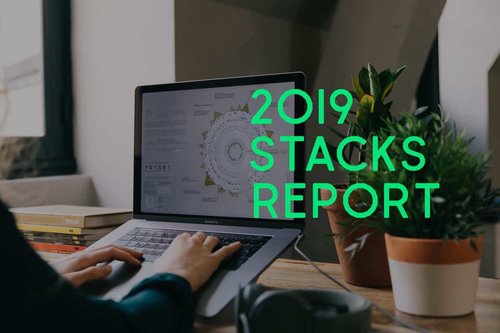Career Hacking Event #1: How to Create the Right Onboarding Process
11 jul 2019
8 min


Freelance writer
Developers in particular are hard to hold onto: This area currently has one of the highest turnover rates in the market. A LinkedIn study published in March 2018 showed that up to 21.7% of data analysts and embedded software engineers left their place of work in 2017. Because of that, the question companies need to ask is: How do we create a nurturing environment that will encourage them to stay? First impressions are often the lasting ones, so it’s a good idea to pay close attention to your onboarding processes.
To help you onboard the next developers you hire, we hosted a Behind the Code Career Hacking event on June 26 in Paris and interviewed two professionals from the industry to find out more about the approach their organizations follow:
- Sylvain Utard: VP of Engineering at Algolia, a Parisian B2B company that offers a search engine as a service and has 350 employees, 110 of whom are in the tech team. In 2018, it recruited about 170 new collaborators and, within its very diverse Parisian office, more than 20 nationalities are represented.
- Tugdual de Kerviler: Developer at Automattic (the company behind WordPress.com). De Kerviler works with a team of 900+ people, who all work remotely, and of whom 350 are developers. Automattic hires about 150 people per year.

Build an automated onboarding plan
To determine where you and your new recruits are headed from the get-go, it’s best to use an onboarding plan. This should contain a basic list of the information every new recruit needs to know and cover topics ranging from holidays to how to deploy new code.
Algolia usually finalizes plans like this, containing 30-, 60- and 90-day milestones, a week or so before the developer arrives. For Utard, a launch plan needs to answer the main questions a new recruit is going to be asking: “A new employee needs guidelines. They’ll be asking themselves things like, what is expected of me and how can I do a good job?”
And while the first stages of welcoming a new developer are relatively easy, it can be easy to get caught up in the daily rhythm of work again and forget a few things you’d been meaning to explain to your new developer.
To avoid this scenario, Automattic and Algolia have both developed automated processes. Utard explained that creating a Slack bot can be a very efficient way to remind the rest of the team about the various steps onboarding a new teammate involves: “A week before the onboarding, the manager will receive a message from a Slack bot. They’ll answer a few questions and it will generate the onboarding plan, which will then be sent to the new developer.” This won’t take a lot of time for the manager—one hour at most, according to Utard—but it’s a very efficient way to gather information. Meanwhile, at Automattic, a Donut bot is put in place to remind the team of what should be happening, day by day, during the onboarding process.
Talk about security right away
De Kerviler and Utard agreed that trusting your new hires with security is a good way to make them feel welcome, but it needs to be backed by rules that are actually enforced.
The first week is a good time to explain to your new developers how your company deals with security. At Algolia, every newbie is given the relevant training. “The employees don’t get their work phone or computer before they’ve had some security training,” confirmed Utard. During this training, the company makes sure every employee uses a password manager such as LastPass or 1Password and knows about the two-factor authentication and phishing.
Regarding external tools and technologies used by developers, be clear from the beginning about which ones are authorized and which are not because of security issues. An example is a developer using a cloud-based integrated development environment (IDE): You’ll need to make sure in advance that the platform won’t cause a security breach for your company as a whole.
Clarifying the security policy not only benefits the company but the developer, too, because if they’re not worried about it, they’ll be able to focus more efficiently on their work.
Build and maintain a knowledge base
A key component of a successful onboarding is access to the tools and information the developer will need to perform their work efficiently. A good knowledge base is absolutely crucial when it comes to learning how your company works and making informed decisions.
“The goal during their first weeks at the company is to provide the tools necessary for navigating all the information,” explained de Kerviler. To that end, Automattic has set up a Wiki that covers every process used by the company, giving step-by-step descriptions and answering frequently asked questions; this is also updated as soon as a new process is implemented. Two search engines are available: One is aimed at the Wiki, the other at resources from Slack and GitHub. At Algolia, the knowledge base is structured on Confluence, with how-to articles detailing typical aspects of the job. The ideal way to create a knowledge base is to use a tool your teams are already familiar with. This makes it easier for them to gather data and make a habit of it.
Access to information is also about documenting what your team does on a daily basis. You and your team should use readmes wherever you can. For instance, at Automattic, every package and module gets its own readme, meaning no one has any trouble understanding what it’s about.
The continuous integration/continuous delivery (CI/CD) pipeline is another useful way to share knowledge about good practices in coding. “There are a lot of things that are automated in the CI/CD pipeline to verify the coding style, and launch ESLint and Prettier,” explained Utard. This helps a developer to immediately see if their code doesn’t match the company’s current standards and should be modified accordingly.
One last thought about code: Don’t forget that your developer might not speak the same corporate language your team is familiar with, so they’ll need some resources on the vocabulary used. Automattic took care of this with a simple tool, as de Kerviler outlined: “We have a glossary on our Wiki that explains every acronym we’re using, every project undertaken, everything that you might hear during a global conversation that someone from outside the company might not understand. There’s a lot of internal jargon.”

Get new developers to deploy code as soon as possible
One of the worst things you could do when you hire people is place them on the sidelines for the first few weeks while they learn the ropes. Even though it might sound like a good idea, Utard and de Kerviler feel it’s actually counterproductive.
At Automattic, the developers even start developing for the company during the interview period. “The recruiting period lasts between 2 and 3 months, and two-thirds of this period is dedicated to a ‘trial project,’ a probation stage where developers are paid for working on company problematics,” said de Kerviler. This trial period not only means the expertise and soft skills of the developer are tested in real conditions, such as how they handle feedback from other developers, it also allows them to become acclimated to the company’s culture, process, and tools.
According to Utard,“the business impact of the first developed feature is not very important—what matters most is deploying it.” Algolia tries to encourage its developers to launch a new feature within 3 to 6 weeks of joining the company, though the new developer should know they’re not going to get punished for making a mistake. It needs to be made clear that this onboarding period is more about learning than performing.
Utard also advised paying attention to how your projects are named. As tempting as it is to let your team choose names based on references to Star Wars or Harry Potter, you should still make sure they’re understandable to any new employee!
Create a caring environment
Being able to offer a caring environment is key when you’re hiring new developers. One stumbling block some companies come across is developing good team spirit when a large part of your workforce works remotely, as is the case with Automattic.
To overcome this, Automattic uses several tools to make sure no one feels isolated. “Each new developer will receive a welcome post on the team forum, and then the team lead will talk directly to them via video call,” said de Kerviler. At the beginning, it’s also a good idea to film a short presentation given by your new hire that can be sent to the rest of the team as a way of introducing them. De Kerviler explained how this has become a tradition at Automattic. The resulting collection of video introductions can be played back to the new hires, too, making it a great way for them to get an idea of who their teammates are.
You’ll also need to make sure your new developer is well supported. The team leader will obviously be the first point of contact, but they shouldn’t be the only one talking to them. To promote friendship, you can use the “buddy system.” Utard explained that two buddies are assigned to each new employee at Algolia: One within the team the new hire will be working in, and one outside it. The “internal” buddy will mostly be a point of contact for questions related to work, while the “external” one will be more of a friendly presence: They’ll have lunch with the new recruit and offer an additional channel of communication.
Additionally, organizing team meetups are a great idea: They don’t have to be a monthly occurrence, but they ought to happen semi-regularly. Developers in general might be slightly allergic to meetups, but they’re a great way to meet the whole “family” and to build good team spirit.

Intermingle teams
An effective way of intermingling teams is to set up meetings with various teams, rather than just the one the new recruit will be working with. You can even set up an automated tool: A simple Slack channel can randomly pair together two people so they get to take lunch with someone new every week.
Another way of making sure your teams intermingle well is having your new developer take on a slightly different role from the one they’re going take at the end of the onboarding process. For instance, Automattic assigns their new developers to technical support for a couple of weeks when they start, and Algolia sometimes has them shadow other non-technical teams, such as the sales team. This allows the new hires to see the company from a different point of view, and when they get back to their assigned role, they have a better grasp of how most people use the solutions they’re developing.
To promote company culture, you can also use “goodies.” During their first couple of days on the job, give them branded T-shirts or bags, or even stickers. It’s a small gesture, but it’s a great way of showing that they’re a part of the family now.
Adapt your onboarding to the size of your team
Scalability is key when it comes to developing a company, so the onboarding process should also be tailored to its size. De Kerviler explained that Automattic had to hire someone who specializes in onboarding, a step your company might want to take as it grows.
Even when all of the tools are in place, you should revisit your onboarding strategy periodically. This will help you to always be one step ahead. Utard said that, because of its own fast growth, Algolia had to update its onboarding process every six months. At the beginning, it doesn’t matter when you onboard people, but as the team grows, it’s wise to set specific periods so that it’s possible to manage the new arrivals in an efficient way. “Currently, we only have two batches per month,” explained Utard, who insists on disrupting routines regularly. “These evolutions are incredibly necessary to continue to be efficient and make sure nobody is wasting their time.”
Also, don’t hesitate to send a survey to your new employees to find out what worked and what didn’t, so that you can constantly adapt your onboarding process as necessary.
So, now you know a bit more about onboarding new developers. But don’t forget that the process has another advantage: It’s the perfect time for a company to think about its identity, its culture, and the processes it’s been using. Taking care of the first stages means your developers will be more inclined to stay at your company for a long time.
Check out the full video of the event (in French):
This article is part of Behind the Code, the media for developers, by developers. Discover more articles and videos by visiting Behind the Code!
Want to contribute? Get published!
Follow us on Twitter to stay tuned!
Illustrations by WTTJ

Más inspiración: Career hacking
Because being a developer is not just about coding, we want to share dedicated tips on soft skills and career paths, help you stay up-to-date with your favorite technologies, and learn more about the job market.

Computing’s Gender Divide: Why Tech Is Stuck in the 1980s
Discover why the percentage of women who held computing-based jobs has been in a steady decline since the 1980s.
14 sept 2020

5 Remote-work Lessons From the Open-source Community
The open-source movement has a few things it can share about remote working with the wider software-development community.
09 jun 2020

2019 Stacks Report
The most-mentioned technologies in the job specifications published on WTTJ's website in 2019 and the average number of applicants per technology.
21 abr 2020

Engineering Management: An Interview with Saad Rehmani
Saad Rehmani, the VP of Engineering at Reddit, shares his most effective management strategies to handle the COVID-19 crisis.
07 abr 2020

Engineering Management: An Interview with Rich Archbold
Rich Archbold, the VP of Engineering at Intercom, explains how to develop a management style and how to transition to managing other managers.
17 mar 2020

¿Estás buscando tu próxima oportunidad laboral?
Más de 200.000 candidatos han encontrado trabajo en Welcome to the Jungle
Explorar ofertas